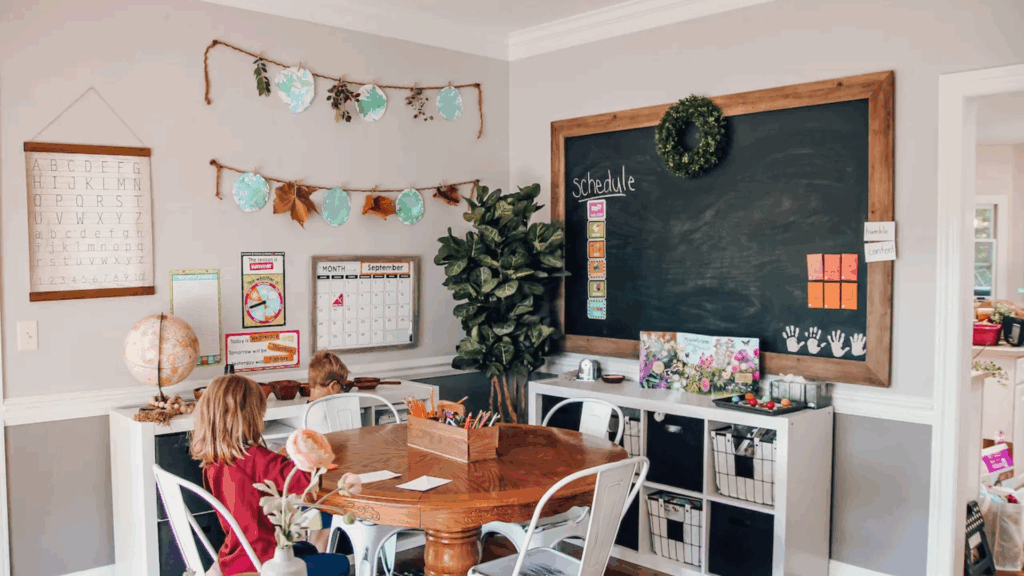Setting up a homeschool room can feel like a lot, especially when you want it to be neat, fun, and easy to use.
I get it – you’re trying to keep books, supplies, and learning tools in one spot without it turning into a big mess.
You want a space that works for your child and your home. That’s why I’ve put together some ideas that can help you make a better setup, no matter how big or small your space is.
These tips are made to keep things simple and organized, so learning at home feels smoother and less stressful.
Whether you need a full homeschool classroom or just a quiet corner, I’ve got something here for you.
I’ve looked at what works for real families and gathered the kind of ideas that save time, space, and effort.
Let’s turn your homeschool space into something that helps your child learn better every day.
Why Homeschool Room Organization Matters
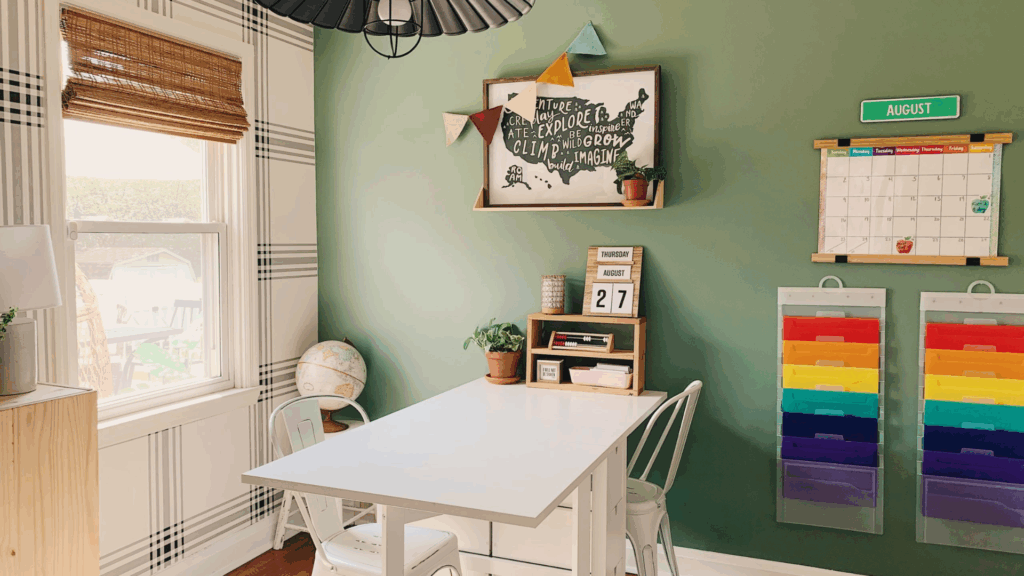
When your homeschool room is set up well, learning feels easier.
A tidy, well-organized space helps kids stay focused and keeps everything they need close by. When each item has a place, the room feels calm and ready for learning.
A big space isn’t needed-just smart use of the space that’s already there. Even small updates, such as rearranging furniture or adding storage bins, can significantly improve the day’s workflow.
A well-planned setup saves time, lowers stress, and keeps lessons on track.
If the day feels scattered, a better layout might help bring things back in order.
Here’s why it matters:
- Less clutter means fewer distractions.
- Supplies are easy to find and put away.
- Kids learn how to stay organized.
- It sets a steady rhythm for daily learning.
Homeschool Room Ideas to Try Now
These ideas can help you set up a learning space that’s neat, simple, and works for your family. Use them to create a homeschool room that fits your space, your needs, and your daily routine.
1. Corner Desk Learning Station
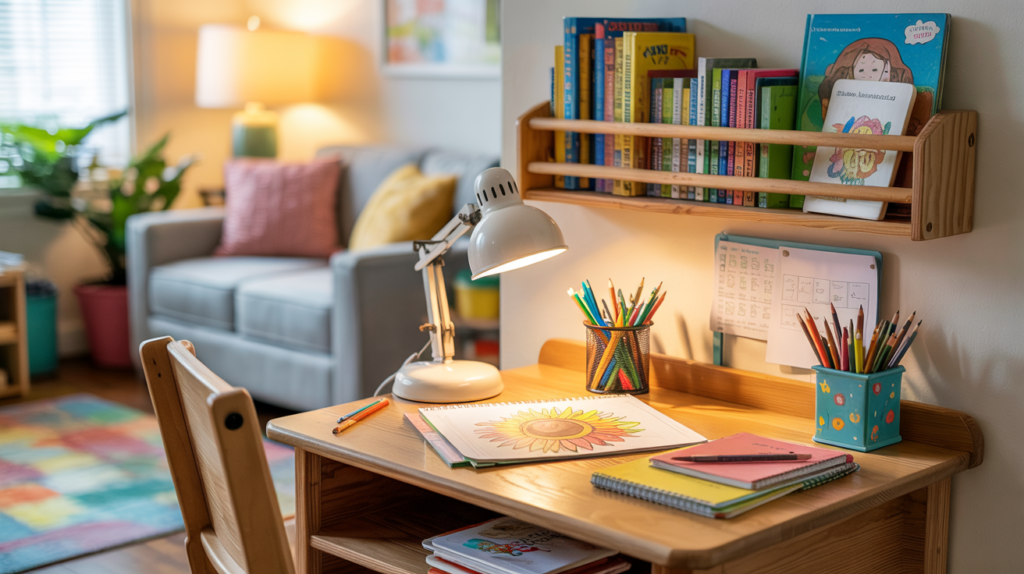
If you don’t have a full room to spare, a quiet corner can still work well. Place a simple desk and chair in a corner of your living room, dining area, or even a hallway.
Add a small shelf or wall rack above it to hold books, pencils, and papers. This keeps things in one spot and gives your child a clear place to focus.
Using a corner also helps keep the rest of your home neat while still having a learning space that feels special and set apart.
2. Built-In Bookshelves

A wall of shelves can do a lot for your homeschool room. You can store books, binders, learning games, and supplies all in one spot.
Built-in shelves don’t take up floor space and help keep things off tables and chairs. If you organize them by subject or child, it’s easy to find what you need.
Add baskets or bins for smaller things like flashcards or art tools. Having everything within reach saves time and helps kids get ready for learning without making a mess.
3. Pegboard Supply Wall
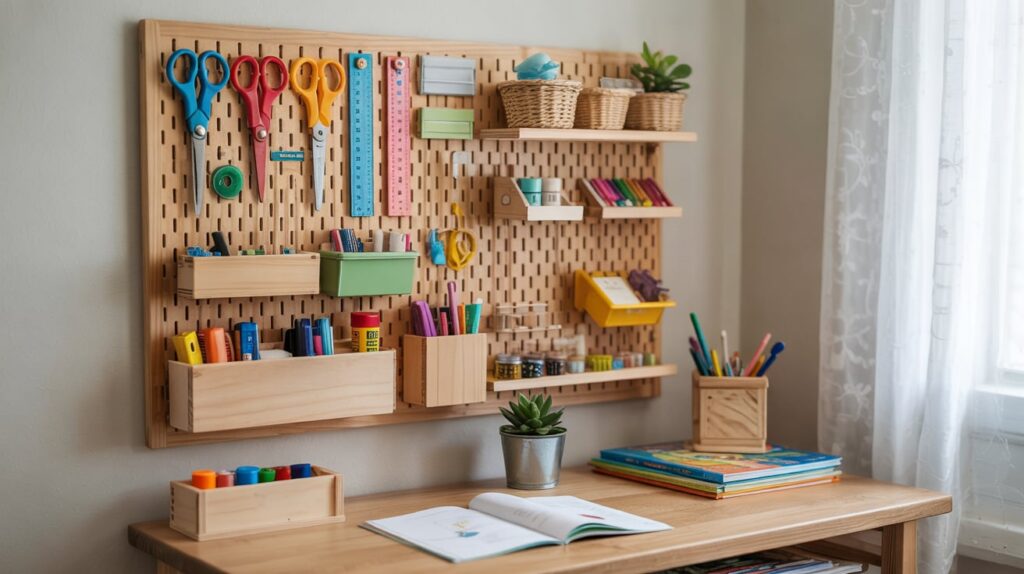
A pegboard is a great way to keep your homeschool room tidy. Hang one on the wall and use hooks or small baskets to store scissors, tape, rulers, glue, and even headphones.
You can move things around easily as your needs change.
Pegboards work especially well in small spaces because they use wall space instead of the floor or desk.
Kids can see what they need and put things back when they’re done. It also adds a fun, creative look to your learning space.
4. Rolling Storage Cart
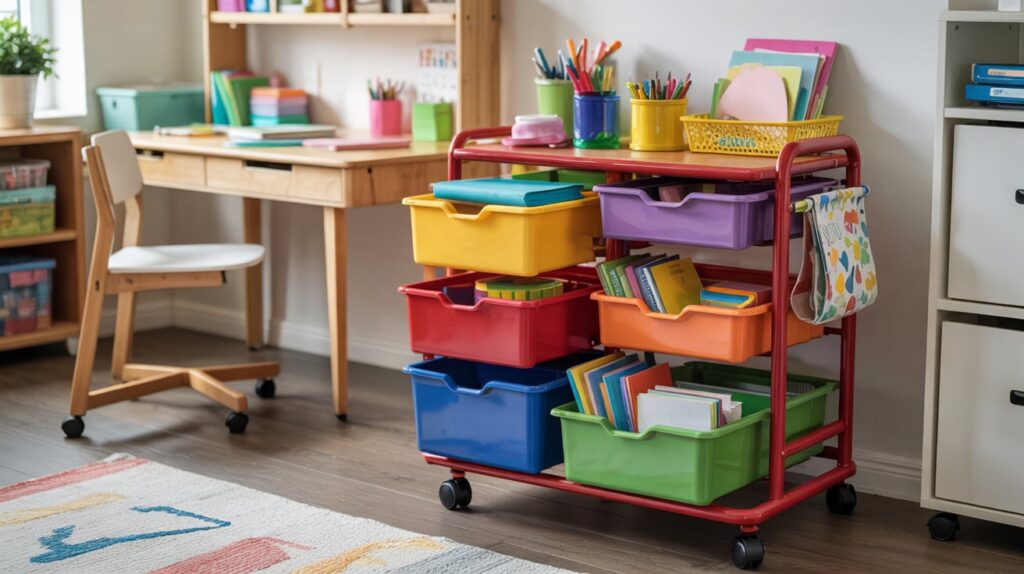
Rolling carts are super helpful when you need a lot of supplies but don’t want them spread out everywhere.
Choose a cart with drawers or bins and fill each one with books, crayons, papers, or folders. You can move it from room to room or slide it next to a desk when it’s time to work.
When school is over, just roll it into a closet or corner. It’s great for families that homeschool in shared spaces like the kitchen or living room.
5. Color-Coded Bins
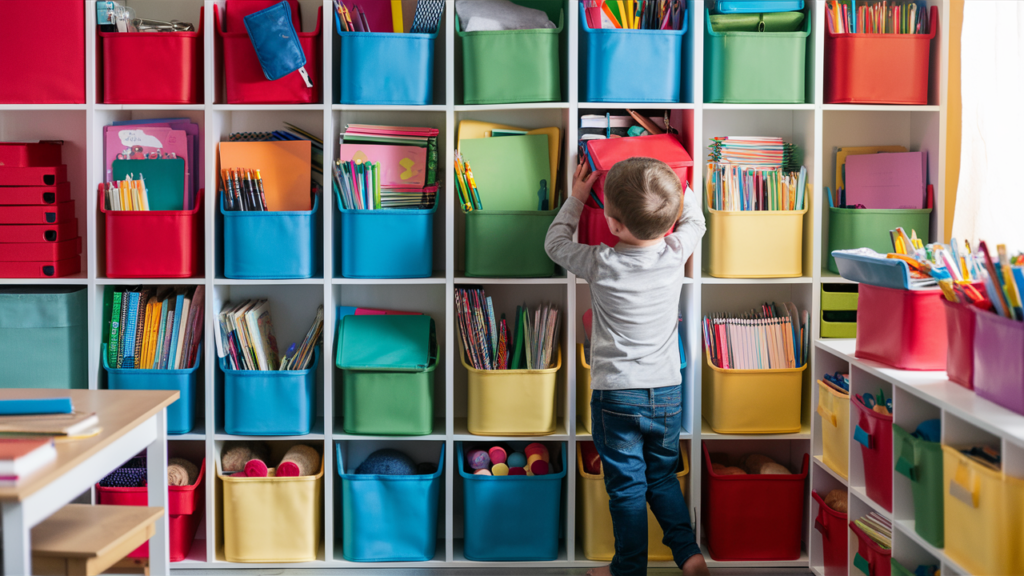
Color-coding your storage is a smart way to keep everything organized.
You can use one color for math, another for reading, and another for science, or give each child their own color.
Use bins, folders, or even labels to match the color system. This helps kids know where to find their things and where to put them back.
It also makes it easier for parents to keep track of everything. Plus, bright colors make the homeschool room feel more cheerful and inviting.
6. DIY Display Board
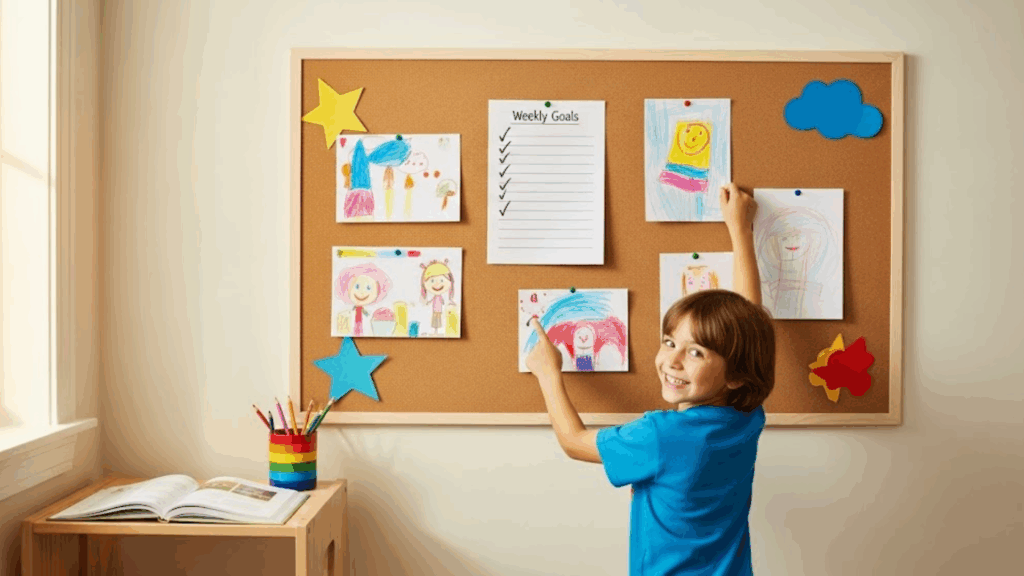
A display board is a simple way to show off your child’s work and keep them excited about learning. You can use a corkboard, a magnet board, or even a piece of foam board.
Hang it at eye level and let your child pin up drawings, assignments, or weekly goals. This makes the space feel personal and keeps important reminders in view.
You can also use it for a rotating schedule, spelling words, or a reward chart. It’s an easy way to turn a blank wall into something useful.
7. Fold-Down Wall Desk
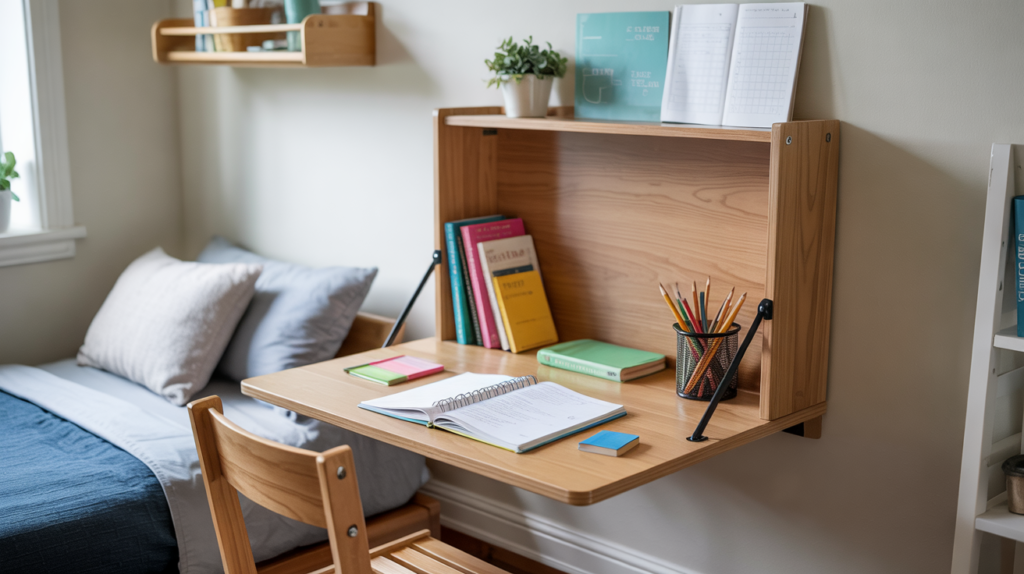
A fold-down desk is great if you’re short on space. It stays flat against the wall when you’re not using it and folds down into a table when it’s time to work.
You can buy one or build your own if you’re handy. It works well in bedrooms, hallways, or tight spots.
Add a wall shelf above it for storing books and supplies.
When school is done, just fold it back up. It helps keep your home tidy while still giving your child a place to learn.
8. Reading Nook with Floor Cushions
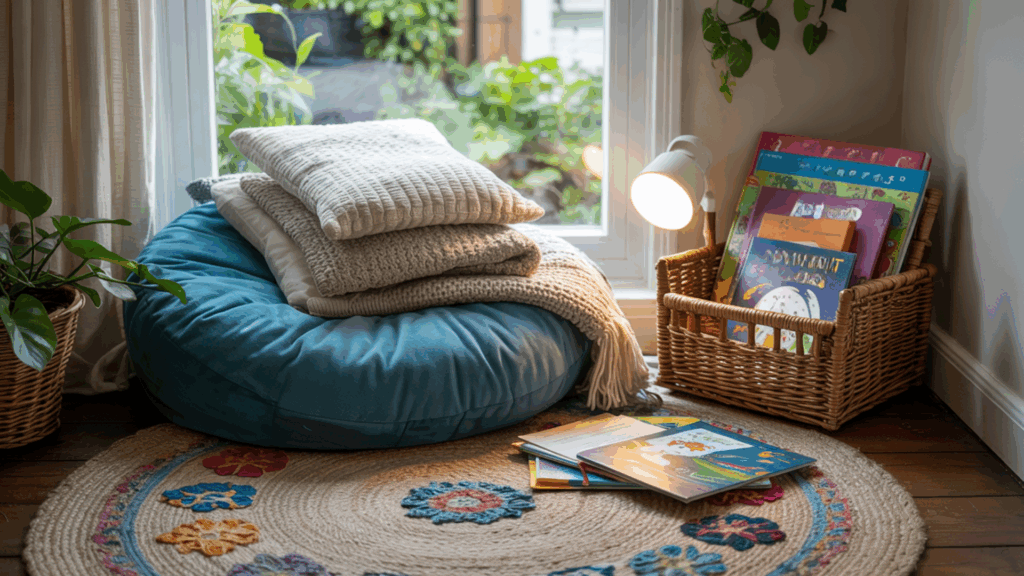
Create a cozy reading spot with just a few floor cushions and a small basket of books.
Find a quiet corner, maybe by a window or next to a shelf, and lie down on soft pillows or a small rug.
This gives your child a calm space to sit, read, and relax. You can add a clip-on light or a beanbag chair to make it even better.
A reading nook encourages kids to enjoy books and gives them a break from sitting at a desk.
9. Low Shelf Learning Center
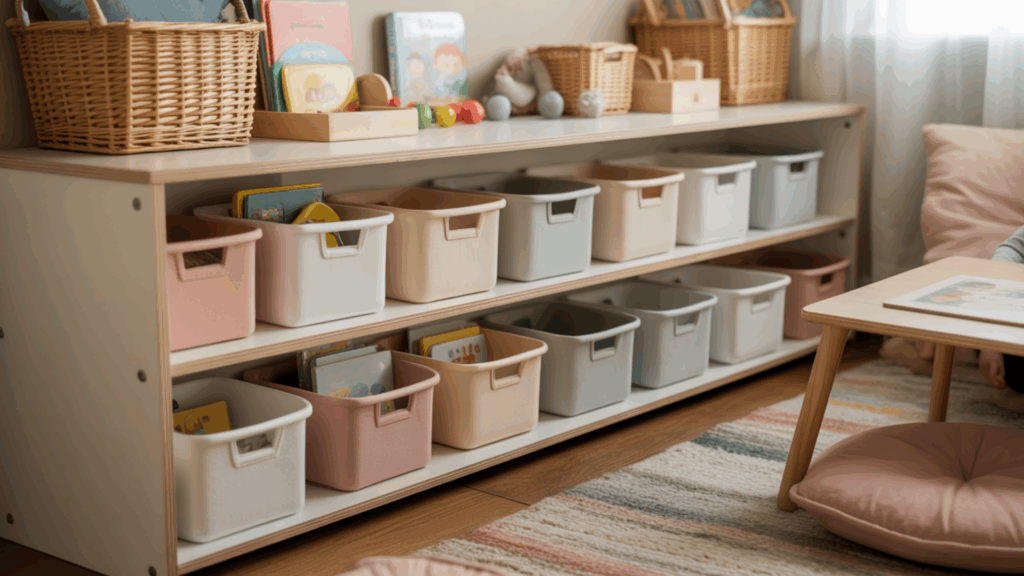
Low shelves help kids reach their own supplies and put them back without help.
You can place baskets or bins on each shelf for different subjects like math, science, or art.
This works well for younger kids who are learning how to stay organized. The setup makes it easy to rotate out activities and keep things fresh.
Label each basket so your child knows what goes where. It keeps clutter off tables and helps create a simple, go-to spot for daily learning.
10. Window Desk Setup
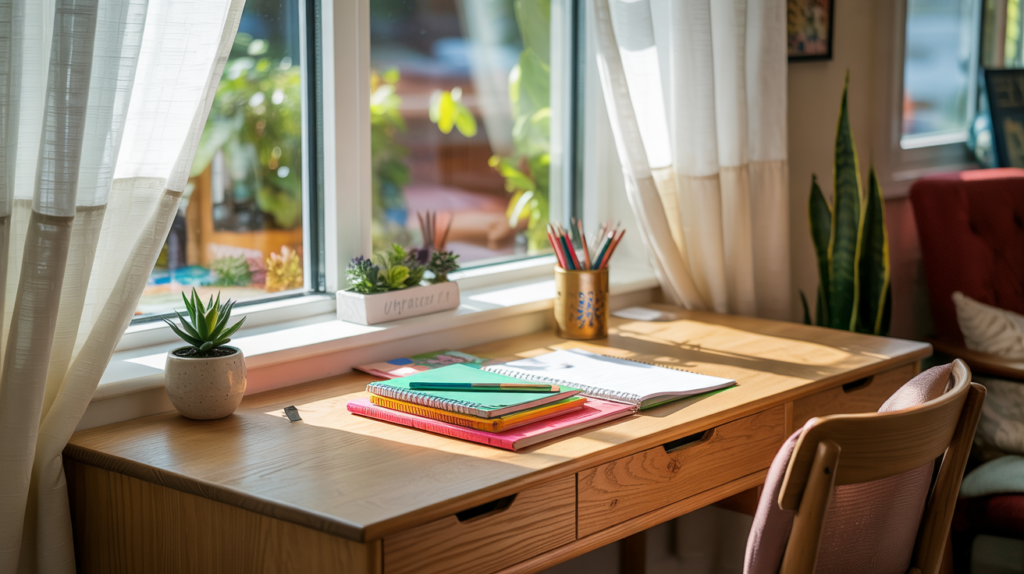
Placing a desk near a window brings in natural light and helps kids feel more awake and focused.
Sunlight is good for mood and energy, especially during long lessons.
Pick a spot where your child won’t be too distracted by outside noise or movement.
Add a small curtain if the light gets too bright. You can even grow a small plant on the windowsill to brighten up the space.
A window desk gives the homeschool room a fresh, happy feel without much effort.
11. Label Everything

Labels make a big difference in keeping your homeschool room neat.
Use simple words or pictures to mark drawers, shelves, bins, and folders. This helps your child know exactly where things go and makes cleanup much faster.
You can use label makers, sticky notes, or printed tags taped on with clear packing tape.
If your kids can’t read yet, try using color codes or pictures instead. Labeling teaches kids to stay organized and take care of their supplies.
It also saves time searching for books, pencils, or papers during the day.
12. Closet-to-Workspace Makeover
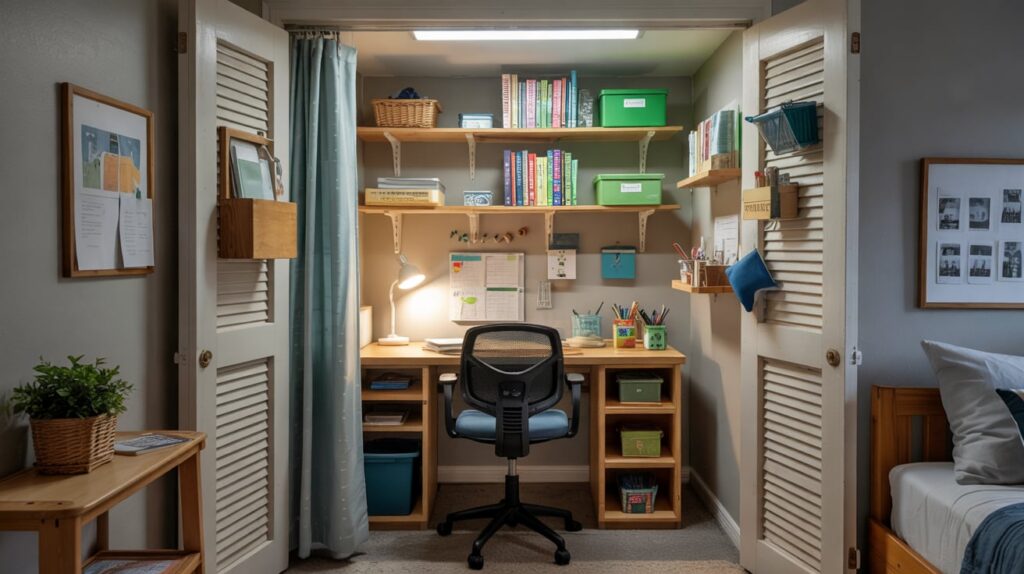
A small closet can turn into a great homeschool room if you remove the doors and add a desk inside.
Use shelves above the desk for storing books and supplies. Add a small lamp or light strip so it’s easy to see.
When school’s over, you can close the doors or hang a curtain to hide the space.
This works well in bedrooms or hallways and keeps the learning area separate from play or rest zones. It’s a smart way to use the space you already have.
13. Art Supply Drawer Unit
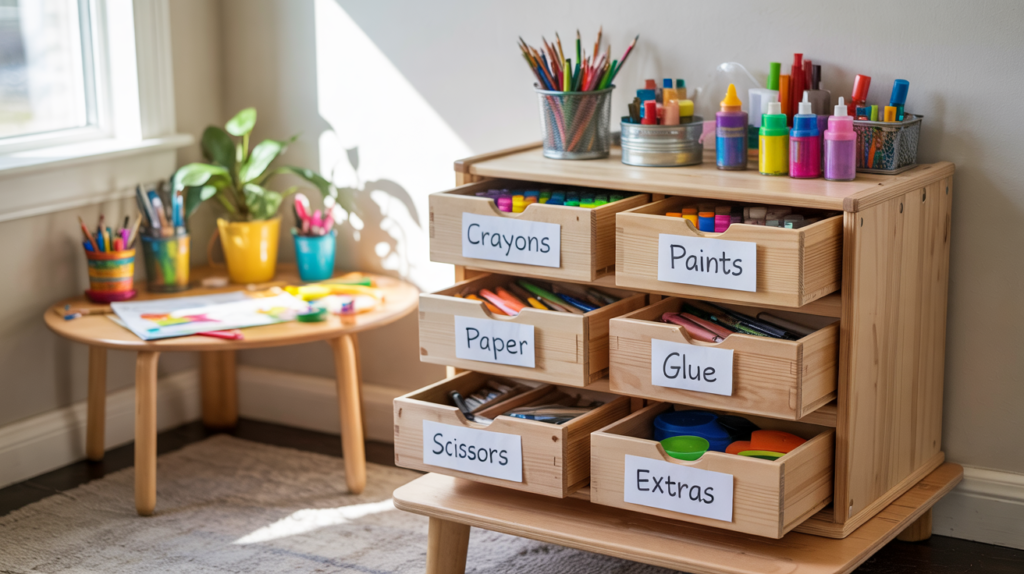
Art projects can get messy fast, so having a drawer unit just for supplies helps keep things under control.
Use a small cabinet or plastic drawers with labels for crayons, paints, paper, glue, and scissors. Make sure it’s easy for kids to open and close on their own.
Keep the most-used supplies on top and extra items in the bottom drawers.
This makes cleanup quick and helps your child stay creative without making a big mess every time they want to draw or paint.
14. Magnetic Wall Calendar
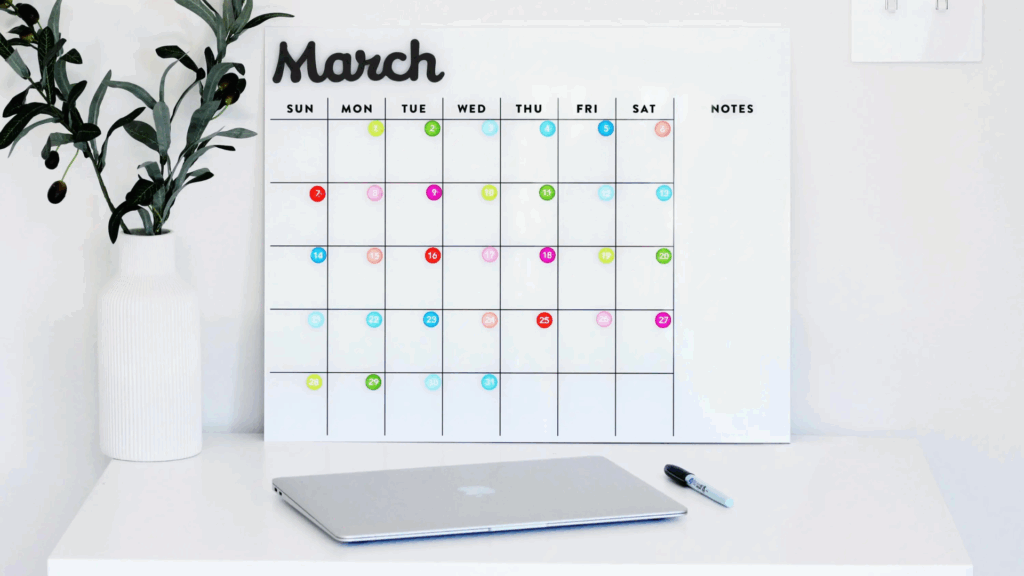
A magnetic calendar gives everyone a clear view of the week ahead.
You can use it to track lessons, activities, breaks, and special projects. Kids like seeing what’s coming, and it helps build a routine.
Write with dry-erase markers or use magnetic labels to mark subjects, due dates, or field trips. Hang it where your child can see it easily.
You can also add a small cork strip for reminders or reward charts. This one tool can help keep the whole family on track.
15. Dual Desk Setup
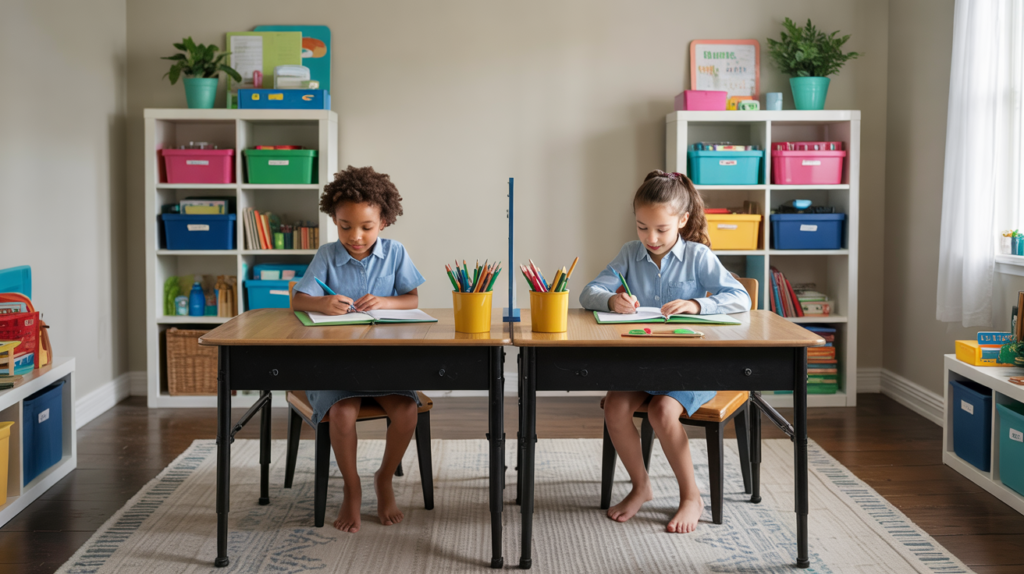
If you’re homeschooling more than one child, a side-by-side desk setup helps them work at the same time without getting in each other’s way.
Place two desks next to each other or use a long table with chairs at each end. Give each child their own space with labeled bins or pencil holders.
Add dividers or shelves between the seats if they need more focus.
This setup is great for group learning, too, since it keeps materials close and routines simple.
16. Adjustable Desk and Chair
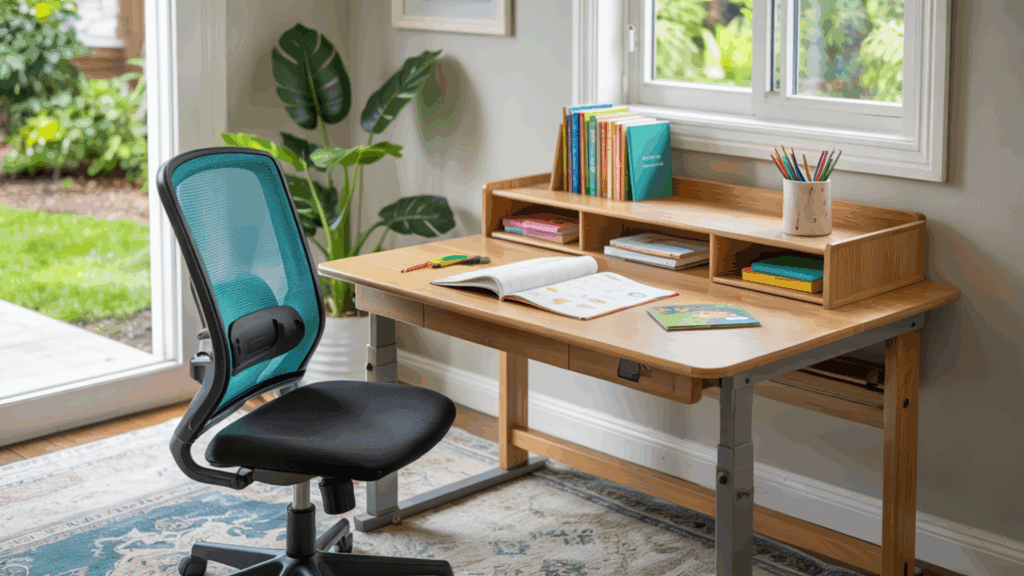
An adjustable desk and chair set can grow with your child and help them stay comfortable during lessons.
You can change the height as your child gets taller, which helps with posture and focus. Look for a chair with back support and a desk with space for books and supplies.
This setup is a smart long-term choice if you plan to homeschool for several years.
It also works well if different kids share the same space, since you can quickly change the height for each one.
17. Wall Hooks for Backpacks
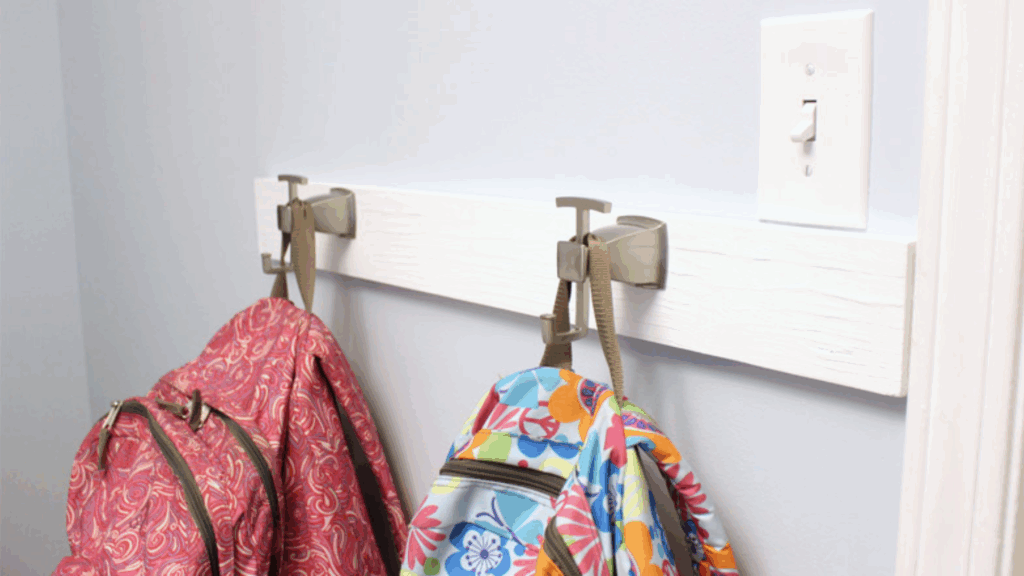
Wall hooks are an easy way to keep bags, jackets, and headphones off the floor.
Place them low enough so your child can hang things up by themselves. You can install them in a hallway, entryway, or right in your homeschool room.
Add names or pictures above each hook if you have more than one child.
This simple trick helps keep the space clean and teaches kids to take care of their things.
It also makes getting started each day a little faster.
18. Under-Bed Storage Boxes
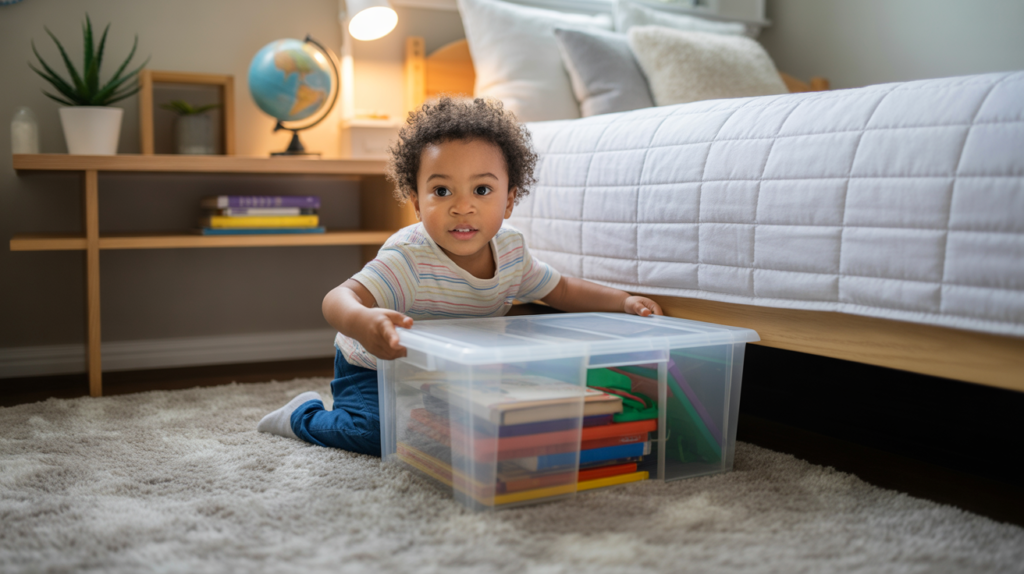
If you’re short on space, try using the area under the bed for homeschool storage.
Flat bins with lids work well for holding books, papers, or extra supplies you don’t use every day.
Label each box so you know what’s inside. This setup is perfect for small homes or shared rooms, where keeping things out of sight matters.
It also helps keep desks and shelves clear of clutter.
Just slide the box out when you need something and push it back in when you’re done.
19. Daily Routine Chart
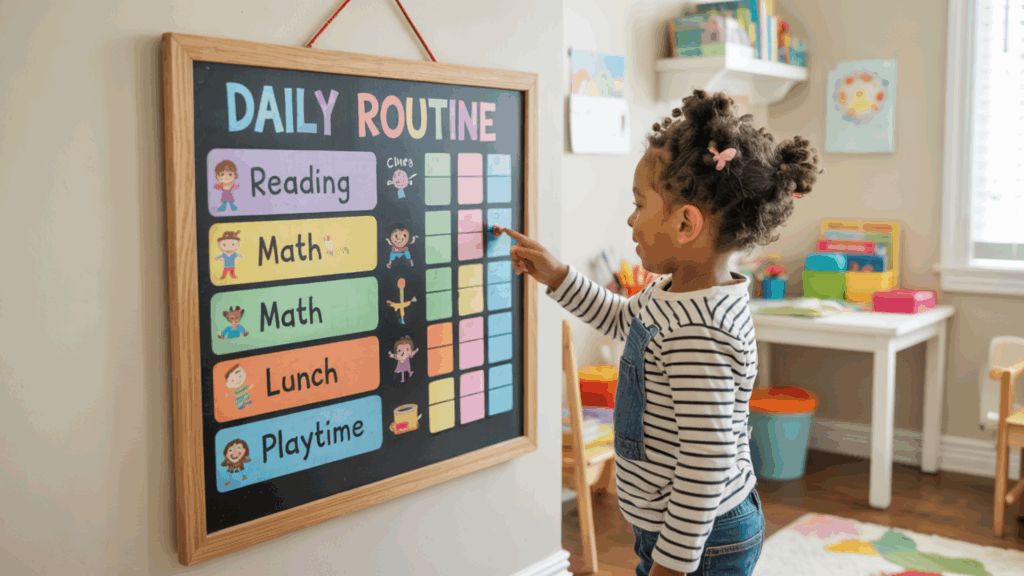
A daily routine chart helps your child know what to expect each day. You can make one with pictures, words, or both.
List out things like reading time, math, lunch break, and playtime in the order they happen. Use a dry-erase board, poster, or even paper taped to the wall.
Check off each part as you go to stay on track.
This helps build good habits and keeps the day running smoothly. Kids feel more relaxed when they can see what’s next.
20. Portable Lap Desk
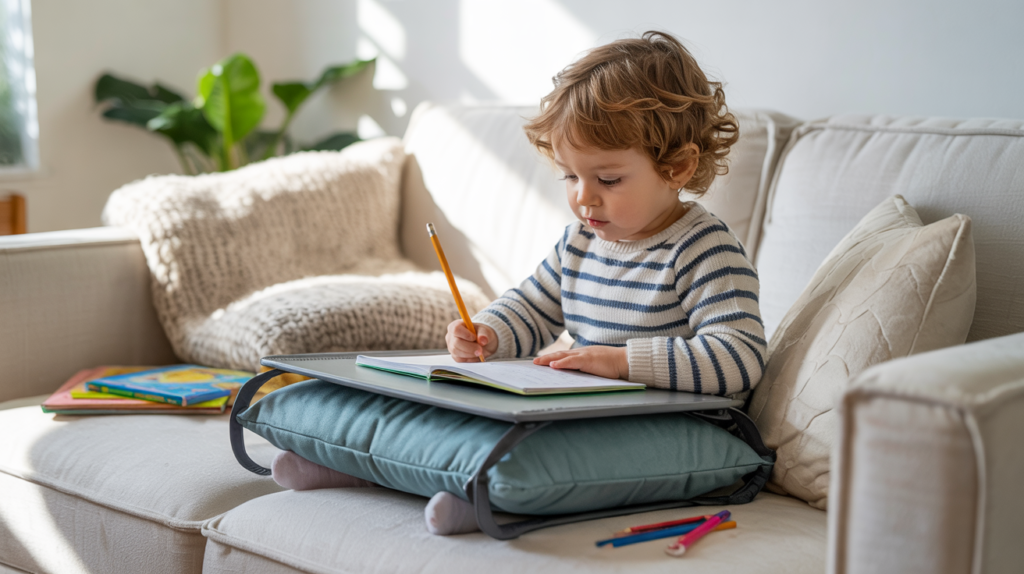
A lap desk lets your child learn anywhere-on the couch, in bed, or even outside.
It has a flat surface for writing and a soft bottom for comfort. Some come with pockets or handles for carrying books and pencils.
This is great for families who don’t have a set homeschool room or who like to change things up.
It also works well for road trips or outdoor lessons.
Having a lap desk gives your child freedom to learn in a way that feels relaxed and fun.
21. Chalkboard Wall Section
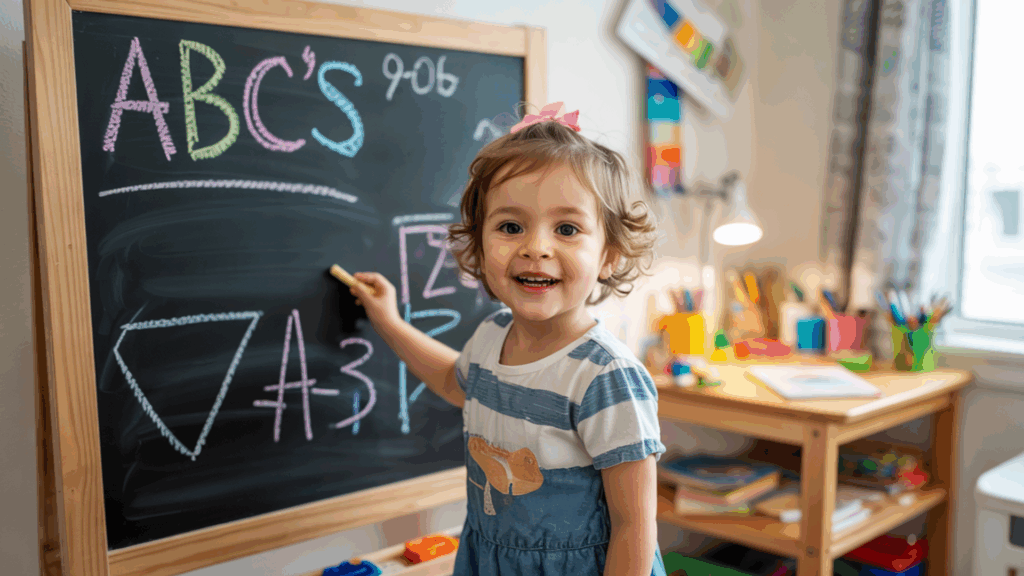
Painting a small part of your wall with chalkboard paint turns it into a fun learning spot.
Kids can use it to practice spelling words, draw pictures, or solve math problems.
It’s also great for writing daily reminders or schedules. If you don’t want to paint directly on the wall, you can hang a large chalkboard instead.
This idea works well for both little kids and older students. It adds a hands-on element to learning and makes your homeschool room feel more like a real classroom.
22. File Folder Organizer
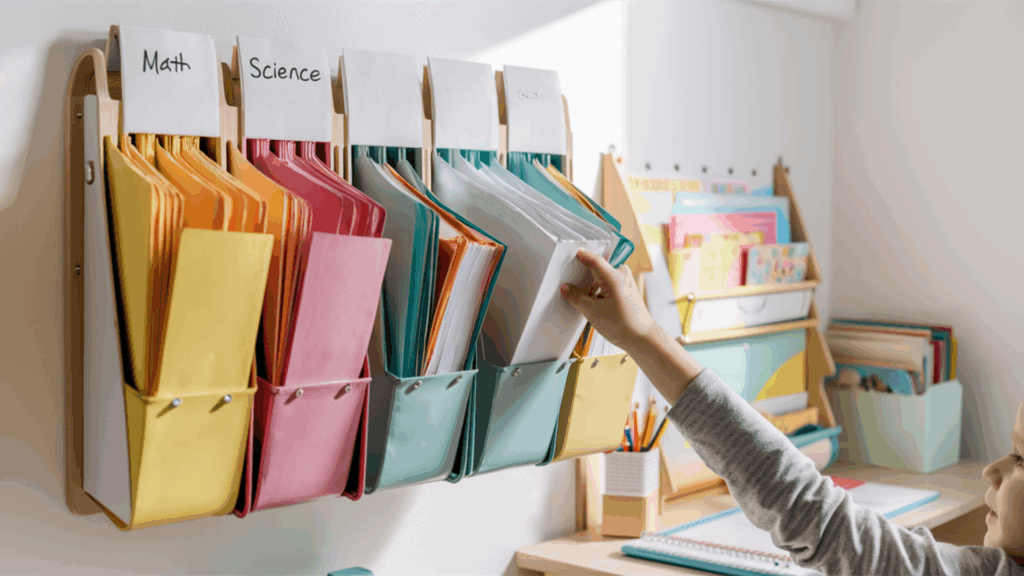
A wall-mounted file organizer helps you keep worksheets, tests, and handouts in order.
Assign each slot to a subject, a day of the week, or a child. That way, you can quickly grab what you need for each lesson.
You can also use it to hold completed work or items that need grading. Hang it near your desk or the main learning area so it’s easy to reach.
This tool helps keep paper piles under control and teaches kids how to manage their own schoolwork.
23. DIY Work Trays
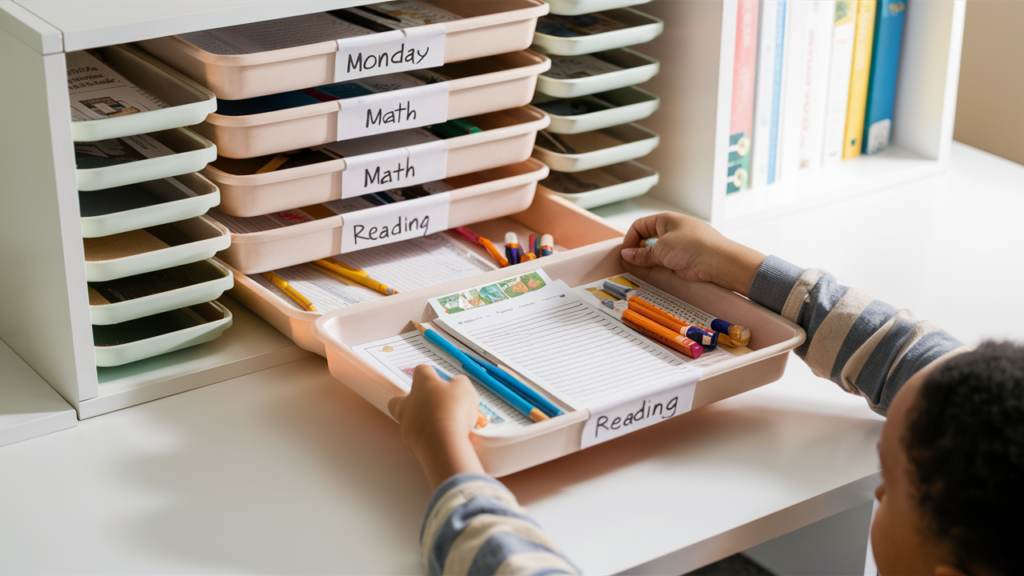
Work trays are a great way to keep daily lessons in one place.
Use plastic trays or shallow boxes and fill each one with everything your child needs for the day, such as books, pencils, worksheets, and small supplies.
Label the trays with days of the week or subjects. When it’s time to start, your child can grab a tray and get to work without needing extra help.
At the end of the day, everything goes back in the tray. It’s simple, clean, and saves time.
24. Quiet Tent or Teepee
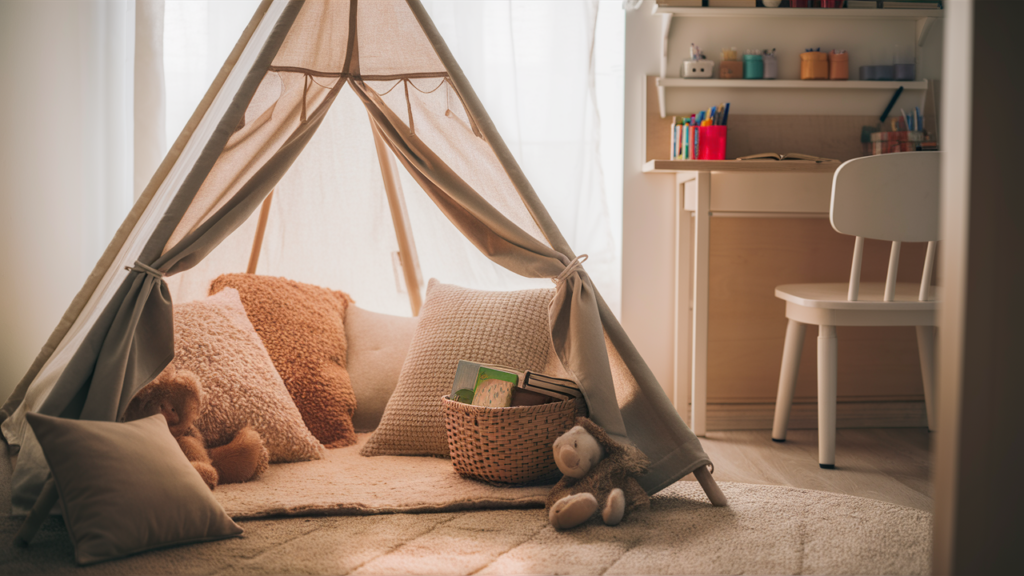
Set up a small tent or teepee in a corner to give your child a quiet space to relax or read. You can add a few pillows, a soft rug, and a basket of books.
This space helps kids take short breaks when they feel overwhelmed or need a change of pace.
It also works well for kids who need a calm spot to reset during the day.
A quiet area like this can make your homeschool room feel more balanced and welcoming.
25. Foldable Room Divider
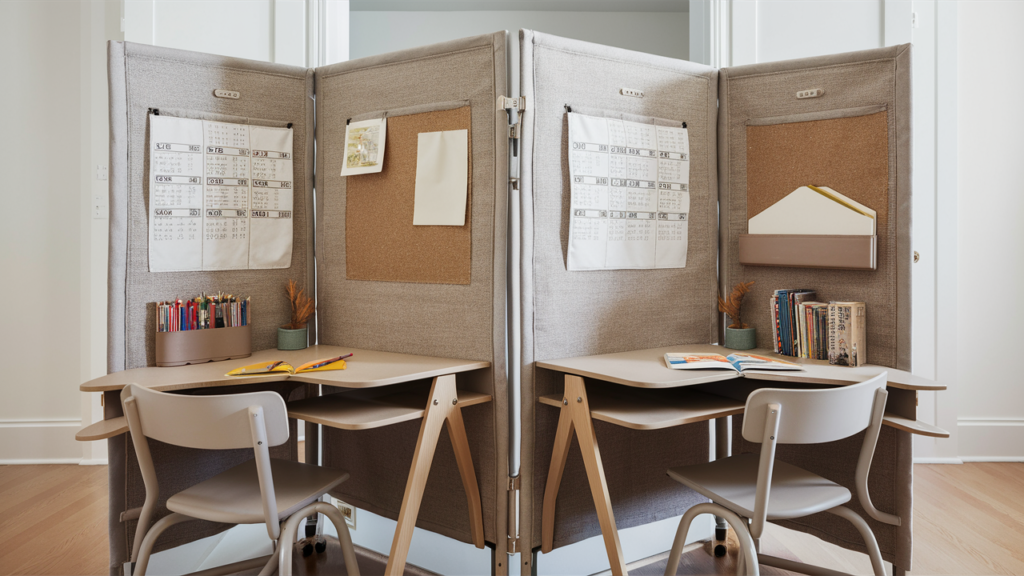
If you’re homeschooling in a shared room, a foldable divider can help separate learning spaces. It gives each child their own area to focus on without distractions.
You can fold it up and store it when school is done, which keeps your home from feeling too crowded.
Some dividers come with pockets or boards where you can post schedules or work. This is helpful if you’re working in a dining room, living room, or other shared space.
It’s a simple way to create structure without needing extra rooms.
Tips for Implementing Homeschool Classroom Ideas
Turning ideas into action can feel tricky, but a few small steps can make a big difference. These tips will help you set up a space that works for your child and keeps learning smooth and simple.
- Start Simple and Use What You Have: Don’t rush to buy new things. Begin with furniture and supplies already in your home.
- Make Organization Easy: Use bins, shelves, and clear labels so everything has a place.
- Keep Supplies Within Reach: Store tools low enough for kids to grab and return on their own.
- Involve Your Child in Setup: Let them help choose where things go so they feel more connected.
- Stay Flexible: Be ready to move things around as your child’s needs and interests change.
Common Mistakes to Avoid in Homeschool Rooms
Even with the best plans, it’s easy to make small mistakes when setting up a homeschool space.
Knowing what to watch out for can save time and reduce stress.
- Trying to Copy a Traditional Classroom: Your home doesn’t need to look like a school. Focus on what works best for your family.
- Overcrowding the Space: Too many desks, shelves, or supplies can make the room feel tight and messy.
- Ignoring Lighting and Comfort: Poor lighting or uncomfortable seating can make it hard for kids to focus.
- Not Creating Storage Solutions: Without proper storage, things pile up fast and create clutter.
- Skipping Routine Setup: A space alone isn’t enough-pair it with a daily routine to keep things on track.
Conclusion
Setting up a homeschool room doesn’t have to be perfect. What matters most is that it works for you and your child.
I’ve learned that even small changes, like adding labels or moving a desk, can make a big difference.
These ideas are meant to help you build a space that feels calm, easy to use, and fun to learn in.
Don’t worry if you can’t do everything at once. Start with one or two changes and see how it goes.
Keep what works and adjust what doesn’t. Over time, your homeschool space will grow with your child’s needs.
I hope these ideas gave you new ways to think about learning at home.
Whether your space is big or small, you can create something that supports your child and makes each day a little easier.
If I can do it, you can too, one step at a time.

